Not Much Below the Surface? North Korea’s Nuclear Program and the New SLBM
In May 2015, only a month after key figures in the U.S. military publicly acknowledged the possibility that North Korea has perfected the miniaturization of a nuclear warhead for long-range delivery, the secretive country seems to have confirmed these claims with a series of announcements, including a “successful” submarine launched ballistic missile (SLBM) test at sea. 1, 2 While many experts question the authenticity of these claims, the latest announcements do warrant closer scrutiny, given their implications for regional stability and order. 4 We will begin our discussion with a technical analysis of the latest available evidence about North Korea’s missile technology. Note that we will not consider the claims related to miniaturization, given that there is little open source information to confirm or disprove these claims. Instead, we provide an assessment of the so-called “KN-11” based on official photographs and a video released by the North Korean KCNA. The results of our finding are inconclusive – meaning there is not enough evidence supporting (or refuting) the existence of a functional ICBM or SLBM in North Korea. In the second part of our discussion, we will explore North Korea’s intentions by considering the broader political context within which this latest set of announcements has been made. We argue that these moves correspond to past patterns of North Korean behavior and are likely to be driven by the leadership’s desire to seek attention and possibly draw the United States to the bargaining table whereby North Korea can win important concessions.
The Chain of Events
In early April of this year, Admiral William Gortney, the head of Northern Command and the North American Aerospace Defense, stated that the North Koreans “have the ability to put a nuclear weapon on a KN-08 and shoot it at the homeland. We assess that it’s operational today….” 4 During a Senate Armed Services Committee hearing one week later, both Admiral Samuel Locklear, the head of Pacific Command, and General Curtis Scapparotti, the commander of USFK, corroborated Admiral Gortney’s statement. 5 This is not the first time that these officials have made claims to these effects, 6but it is interesting to note that they come in succession while the debate over missile defense (i.e. THAAD [Terminal High Altitude Area Defense]) has been gaining momentum in Seoul. 7 Even more importantly, they are followed by a new set of announcements from North Korea about its nuclear program.
To be more precise, the North Korean Defense Commission announced on May 20th that they “have had the capability of miniaturizing nuclear warheads… for some time.”8 This claim was preceded by another announcement on May 9th whereby the North Korean state news agency KCNA claimed that “there took place an underwater test-fire of Korean-style powerful strategic submarine ballistic missile.”9 Putting aside for the moment the motives behind these announcements and the context surrounding these events, we consider the validity of this latest claim using the photographs and video released by the North Korean media which will provide some reliable assessments about North Korea’s delivery capability (see Figure 1).
A Picture is (Not) Worth a Thousand Words
As the saying goes, “a picture is worth a thousand words”. Thankfully, the North Korean media has released more than a single photograph of the SLBM launch, which means we can piece together quite an interesting story about the North Korean missile capability using this set of pictures. The video, which was released in early June – more than three weeks after the photos, in what appeared to be a response to early Western analyses – confirms this story.
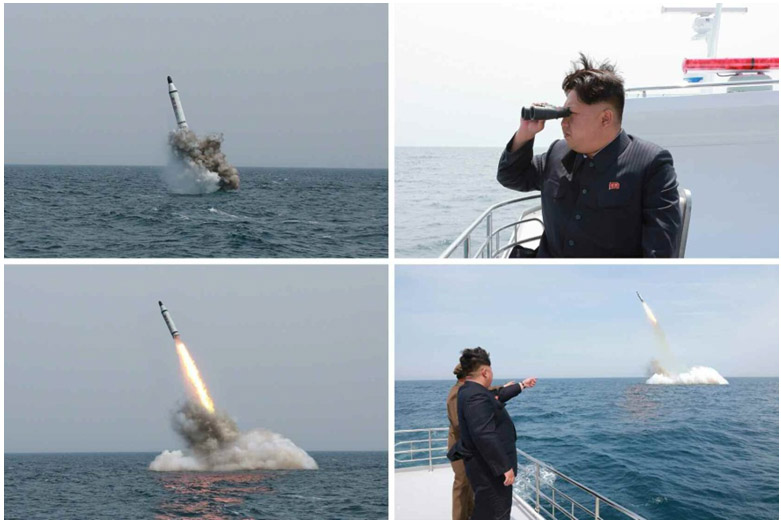
Figure 1. Selection of official launch photos
At first glance, the photos showing the North Korean leader Kim Jong-un observing the test appear to verify the official statement about an underwater missile launch. However, a closer scrutiny reveals that many of these photos were strongly modified. Therefore, technical details of this “missile” and its operational status have to remain unclear; what is clear, however, is that this event was not a full-scale launch of an operational SLBM.
Published Photographs
To date, six different launch photos have been identified from the set of photos that were officially released by North Korean media. 10 Although there may be more, these six are already sufficient for an analysis. The photos are hereby arbitrarily numbered, in this case according to the most likely chronological sequence (Figure 2).
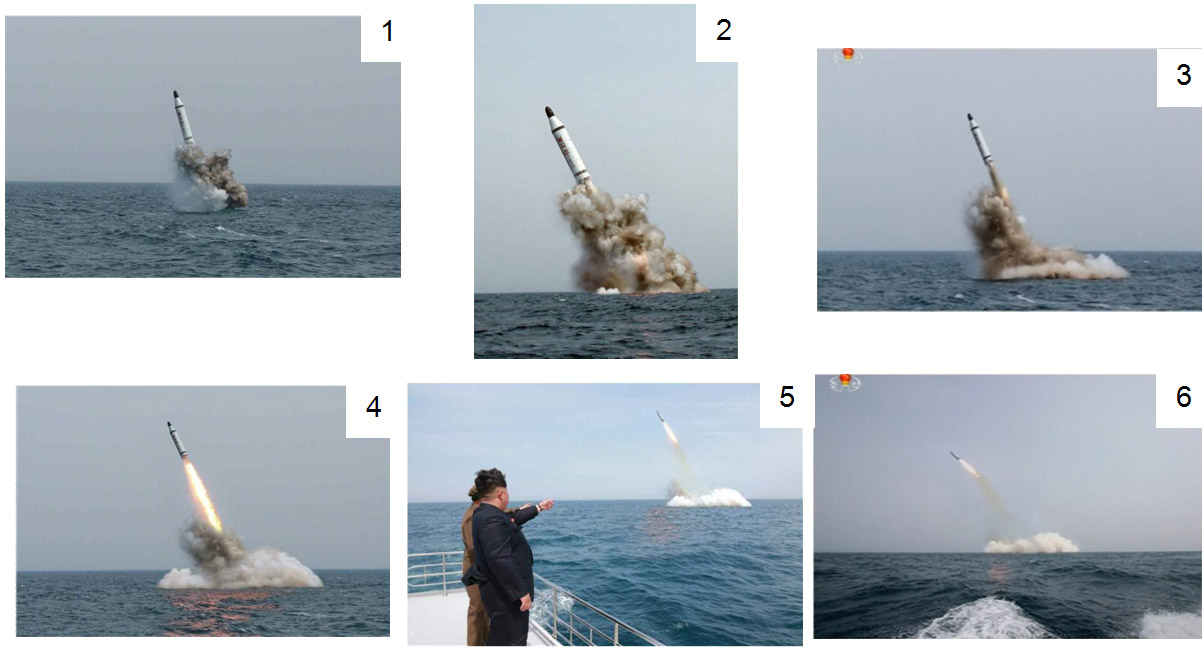
Figure 2. KN-11 launch photos
Missile Characteristics at First Glance
The missile, by now designated the “KN-11” by Western analysts, looks quite similar to the Soviet R-27/SS-N-6 submarine missile that was developed in the 1960s. For more than 10 years now, North Korea is attributed with having access to the SS-N-6 technology, and even having developed a road-mobile version of this missile termed “Musudan”. However, no test of the Musudan has been observed as of yet, and there is no clear evidence that North Korea actually has access to this special kind of technology.
The presented SLBM seems to be a one-stage design with a length-to-diameter ratio of 6. This would mean a length of around 9 m for a diameter of roughly 1.5 m, which is consistent with the original SS-N-6 missile. With comparable size and technology, this missile could offer a performance of perhaps 2,400 km or more with a 650 kg warhead.
Nonetheless, it is important not to make too much out of this resemblance. Comparisons with the geometrical shape of the Chinese JL-1 missile, for example, also yield close similarities, but do not necessarily mean anything.
Launch Analysis
The early trajectory of missiles the size of an SS-N-6 has to be relatively steep for energetic reasons. SLBMs of this size might tilt at quite an angle just after clearing the water surface post submarine ejection, but they quickly readjust their angle to recover the steep trajectory once the engine is ignited. The photographs, however, reveal a different story. In this case, the missile’s trajectory already starts with a noteworthy angle instead of a vertical alignment, and this angle quickly continues to decline instead of recovering. This angled launch is typical for unguided missiles. It could also mean that this specific missile has low thrust or low acceleration.
The photographs also reveal some inconsistent information regarding the propellants used by this missile. The lack of a white smoke trail indicates that the missile does not use composite solid propellants. The lack of brownish-red nitric gases at ignition essentially rules out double-base solid propellants, as well as any liquid-propellant combinations with nitric acid or nitrogen tetroxide (NTO) as an oxidizer (for example, the combination of inhibited red fuming nitric acid (IRFNA) and kerosene). A blackish-grey cloud appears when the missile breaks the water surface and the cloud rapidly turns white; this is very unusual for any rocket launch, be it underwater or land launched. The shining exhaust flame also rules out unsymmetrical dimethylhydrazine (UDMH)-based propellant combinations, which are normally characterized by a transparent flame. In photograph #4, the shining flame seems to be detached from the nozzle by some distance, which in turn would actually indicate a double-base solid propellant. These inconsistencies suggest that there is something wrong with the photographs.
Photo Analysis
A detailed look at the available photographs reveals considerable irregularities and poor Photoshop edits.

Figure 3. KN-11 launch sequence

Figure 4. Identical position of letters and numbers
1. Photograph #2 is not part of the main photo sequence (Figure 3).
- The missile angle is lower than that of photographs #3 and #4; only at photograph #5, the missile starts to show a lower angle.
- If the pictures were not altered and we can assume that they are the same missile, the different angles can only be explained by a different camera position. Careful analysis shows that the red letters on the missile would have to be in a very different position due to the different perspective; however, they appear at the same position as in the other photos (Figure 4).
- The smoke cloud looks distinctly different from the other photos and also lacks the flat white spray water cloud.
- The smoke cloud touches down at the photo’s horizon line.
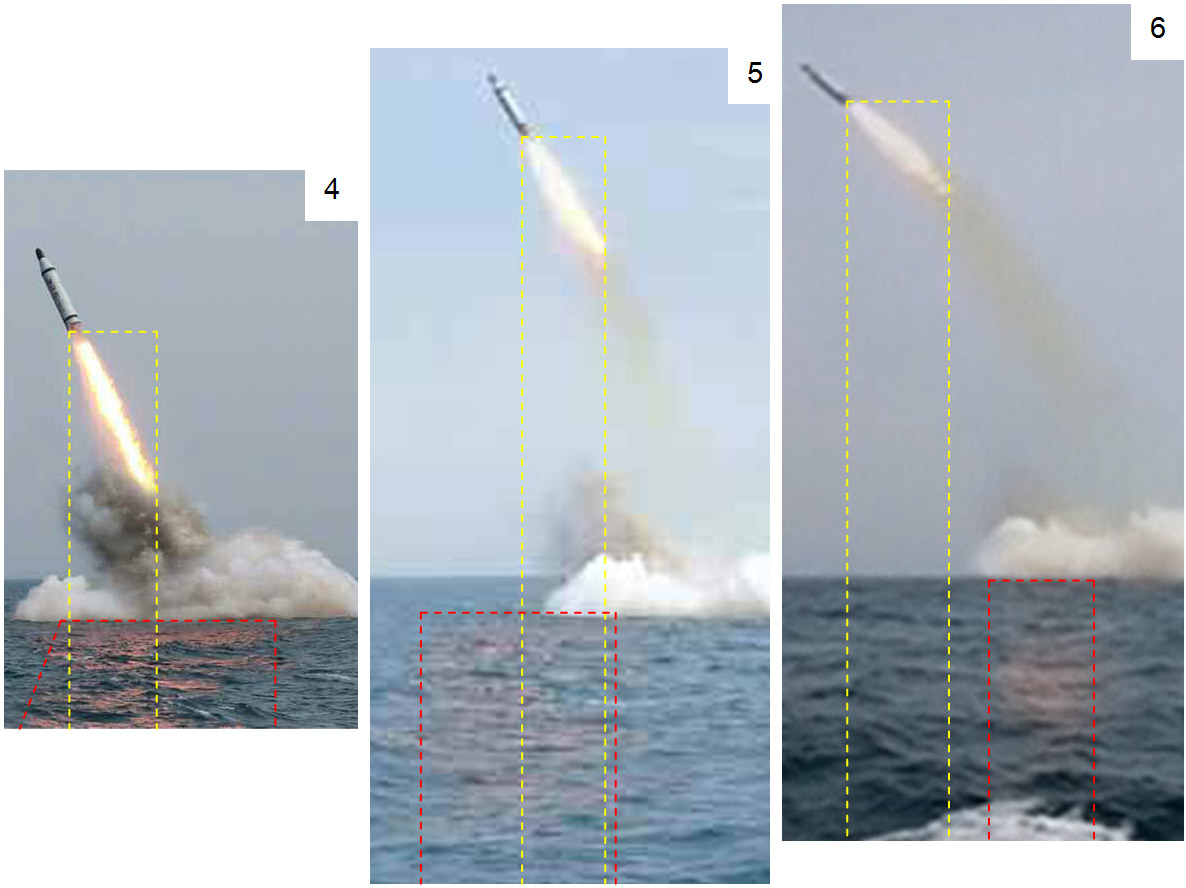
Figure 5. KN-11 exhaust flame reflection in the water
2. Photo 6 is also not part of the main photo sequence. The smoke cloud touches down at the photo’s horizon line, as well (Figure 3).
3. The dark smoke cloud dissipates rapidly from photographs #4 to #5 (Figure 3).
4. The reflection of the shiny exhaust flame in photographs #4, #5, and #6 are inconsistent (Figure 5).
- The reflection looks reddish. The flame itself is yellowish.
- The position of the flame reflection is of differing width, and also misplaced, shifting its relative position to the exhaust flame at each of the photos.

Figure 6. White line along the missile outline
5. There is a white line along parts of the missile in photograph #2 (Figure 6). This is most likely due to heavy photo editing.
6. A closer look at photograph #4 reveals very low-quality Photoshop work at the back end of the missile (Figure 7). Rectangular graphic blocks appear to have been inserted. The detached flame could be a result of this editing. Thus, any conclusions about the propellants derived from the exhaust flame are ambiguous.
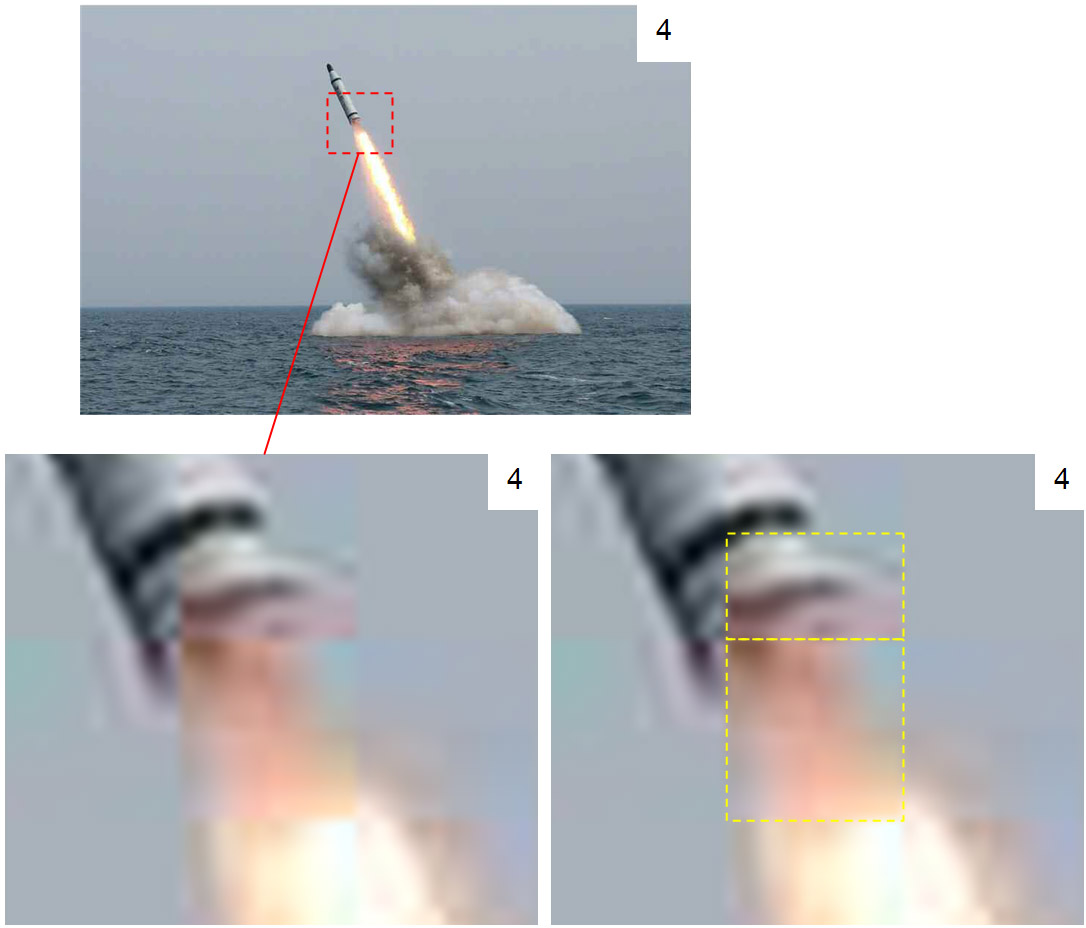
Figure 7. Photoshop editing
Video Analysis
The brief video (of only 1:05 minutes) further shows Kim observing the test, including a total of 3 very short sequences showing a missile in flight (Figure 8). Sequences #A and #C actually consist of two sequences each, first showing the missile breaking through the ocean’s surface, and then quickly cutting to the missile in flight, while sequence #B only shows what looks like the missile in flight.
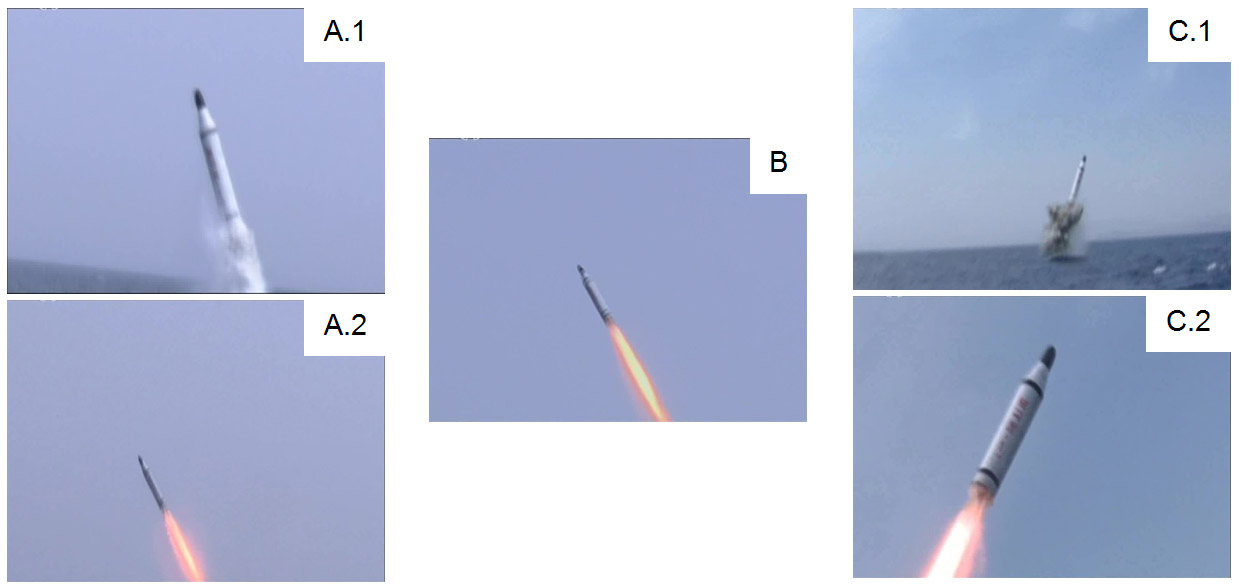
Figure 8. Launch video
sequence
Again, the video is not very convincing, and it appears that its intent is to create a different impression than what was actually shown.
1. The camera work is extremely shaky at sequences #A and #C, perhaps to make an analysis more difficult.
2. There is always a cut between the missile pushing through the surface of the water and the missile flying, thus disclosing the possibility that the in-flight sequences are not connected to the ejection sequences.
3. The dark smoke cloud at sequences #A and #C appears virtually out of nothing and starts disappearing just as quickly, within a few frames of the video (meaning within fractions of a second).
4. A blackish smoke cloud at ignition typically hints toward kerosene as a fuel, with a kerosene-rich ignition sequence. This was demonstrated by the Saturn V Moon rocket, for example, but no missile has yet been identified showing such a characteristic ignition cloud.
5. There is no way to ascertain the size of the missile depicted in the in-flight sequences, and if this is the same missile that was launched out of the water.
6. The length of the flame in the in-flight sequences is too long, more than two times the length of the missile body. Assuming a missile length of 9 m, the flame would be approximately 20 m. Comparable flame-missile length ratios are only known from small artillery rockets.
7. A later sequence just after #A, #B, and #C displays Kim in front of what appears to be the underwater launch site at the right half of the frame, marked by white water with traces of vapor or smoke still hanging in the air. Strangely, there is another area of white water a short distance to the left of the first area (Figure 9). Combining the size of this white water area, the distance of this area to the supposed launch site, and the trajectory of the ejected missile from the available photographs (Figure 3), it is possible that the ejected missile fell back into the ocean at this site.

Figure 9. Two white water areas
All this, along with some other inconsistencies, suggests that the released imagery and video footage was heavily edited by North Korean authorities.
Implied Aspects
The published photos apparently imply some aspects that fail to be validated with careful analysis.

Figure 10. Submarine and
surface ship
1. In several photographs, a submarine is clearly visible, surfaced in some photos and partially submerged in others. This would suggest that the missile was launched by this very submarine. But as was already pointed out on armscontrolwonk.com,11 a photo with a surface ship in close proximity to the launch site, as well as several other indications, point toward a submerged barge being used at this event as opposed to a submarine (Figure 10).
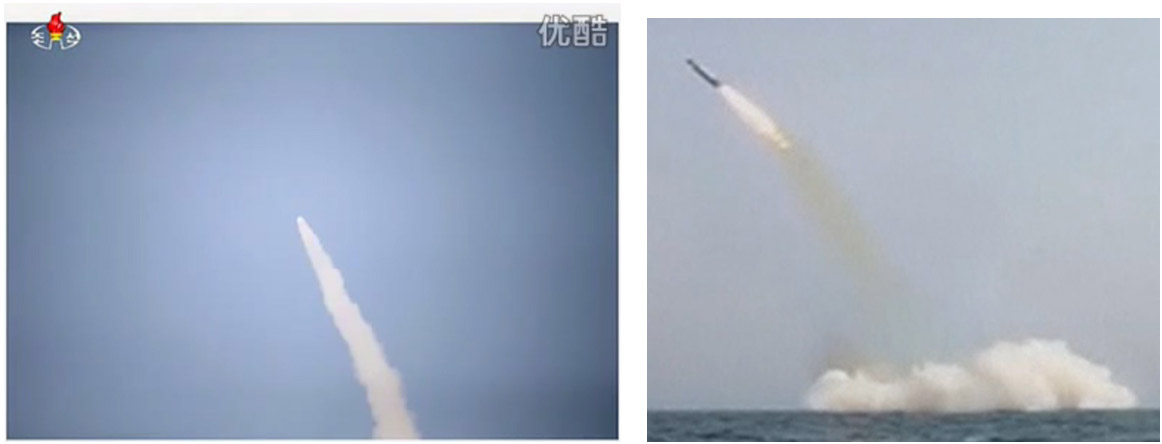
Figure 11. Smoke trail and smokeless missile
2. Another photo publicized on North Korean TV displays a thick white smoke trail high up in the sky, implying that a successful missile launch took place, and also indicating the use of composite solid propellants. However, there is no trace of a white smoke trail in any of the other available launch photographs (Figure 11) or the video.
Questioning Motives
As our discussion has revealed, the photographs and video both prove inadequate in providing a sufficient basis for concluding that North Korea has mastered the technology to enable long range delivery of a miniaturized nuclear warhead. If anything, they do not reveal any new information about the progress of North Korea’s nuclear weapons program. What then might we conclude was the motive behind these announcements? Given the lack of adequate information, we can only speculate.
One possibility is that North Korea possesses a fully functional SLBM but does not want to put “all of their cards on the table”. That is, they may have modified their image productions to keep their true accomplishments clandestine. Of all conceivable scenarios, this is the least likely, given that the authorities could have accomplished the same objective by simply making an announcement without having released any photographs or video. In fact, we would argue that a simple announcement would have been superior to actually releasing any photographs or video footage, given that the poor editing work on these images only raises more questions and causes North Korea to look less credible in the eyes of many outside observers. In this sense, one could argue that these images have had the opposite of the intended effect.
Of course, there is also the possibility that North Korea is releasing bad signals to conceal its capabilities and has every intention of engaging in an armed conflict with the United States and its allies. We would argue that this scenario is only likely if the North Korean authorities truly believe that they can prevail against superior adversaries (i.e. the United States and its allies) in an all-out war. Given the number of instances where the United States has displayed its military prowess in recent years (e.g. Iraq, Afghanistan, and Libya), it is difficult to see how the North Korean leadership could conceivably reach this kind of conclusion. Nonetheless, the possibility that the leadership is engaged in this type of thinking cannot be discounted altogether given the stakes of an armed conflict with North Korea.12 We think that this partially explains the cautionary words from a number of officials within U.S. military circles who have openly acknowledged the existence of a “functional ICBM” in North Korea.
But one could also argue that this was North Korea’s intention from the outset. Assuming that North Korea does not possess long-range strike capability, the “next best” option is to make its adversaries believe that it does. By being deliberately opaque and deceptive, North Korea could be trying to make the United States and its allies unable to choose between an option that involves the use of military force and one that does not. The goal in this scenario is to forestall an imminent attack by keeping its adversaries guessing. Given the recent set of announcements by the U.S. military, one could argue that North Korea is succeeding with this strategy.
There is another scenario where North Korea does not possess long-range strike capability but is instead using these announcements to signal that it intends to develop this technology and subsequently demonstrate how far along it may be in this process. On the one hand, this achieves some of the objectives laid out above, but it also impels the United States and its allies to weigh the possibility of a diplomatic solution to North Korea’s nuclear program. The thinking would run along the following lines: “Given that North Korea has not fully perfected its nuclear capability, could it be possible to negotiate a deal with them in order to halt or delay this process?” This appears to be the guiding principle behind past deals with North Korea and even the current deal with Iran.
The likelihood that North Korea’s strategic logic may follow this line of reasoning is backed by several contextual factors surrounding the recent set of events, as well as a pattern of past practices that corroborates this type of behavior. First and foremost, we must recognize that the targeted recipient of this signal is the United States. Undeniably, North Korea having possession of a nuclear-tipped ICBM sends a strong message to the world, but the intended target of this capability must be none other than the United States, (the greatest threat for North Korea presently). If the United States perceives these images as serious threats to homeland security, U.S. leaders are likely to act. North Korea is staking that the reaction will not involve the use of military force, since the cost of an armed conflict would be too high for the allies, so this leaves open the possibility of diplomatic engagement. Recent moves by the Obama administration to normalize relations with Cuba and finalize a nuclear deal with Iran may have caught Pyongyang’s attention. While the comparison is hardly apropos, the latest SLBM announcement would be one way for Pyongyang to test the allies’ resolve to “stay the course” or revive the Six Party Talks.
An increase in the number of meetings between officials in China, Japan, Russia, South Korea and the United States over the past several months suggests that this “bet” may be paying off. Aside from the fact that South Korean President Park Geun-hye expressed her desire to resume talks with North Korea on several occasions – (the latest being January of this year), there has been a significant upswing in the number of meetings among chief negotiators in the United States, South Korea, and Japan in recent months. But what of China and Russia? As early as March of this year, both countries expressed a willingness to reopen talks, and the chief negotiators appear to be reaching out to their counterparts in these countries.13 While it is unclear how long this consensus may last given the continuing evolution of North Korea’s nuclear program, the latest SLBM test seems to have created some sense of urgency and momentum on the diplomatic side.
Finally, North Korea’s relation with its closest ally in China is deteriorating with each additional test, inviting further rebuke and concern.14 Chinese President Xi Jinping’s visit to Seoul last year marked the first time in history that a Chinese leader visited Seoul without having first visited Pyongyang.15 This change explains North Korea’s interest in improving relations with Russia. It is unclear, however, whether Russia will serve as a more reliable surrogate, as it currently appears to be mired in an economic crisis of its own. Given all this, the conditions are ripe for North Korea to turn instead towards gaining back the attention of its old adversaries. What better way to achieve this than by test launching a SLBM in its development phase?
What of the possibility that North Korea is reacting to the recent military exercises in the region by the US-ROK forces? One could argue that the latest test was a reaction to Key Resolve and Foal Eagle, which took place in March. Indeed, Pyongyang sees these annual U.S. and South Korean military exercises as more than irritable saber-rattling, but that they also warrant vitriolic complaints. Nonetheless they have responded with drills of their own, including firing rounds of mortars on the open sea. And two months is much too long of a delay for a response in the form of a poorly-staged mock SLBM launch.
Perhaps one can formulate a better argument that accounts for North Korea’s broader security dilemma. We cannot lose sight of the fact that North Korea’s desire to build a nuclear arsenal is largely based on its perception of the threat that the United States and U.S. allies pose for North Korea’s national security. Hence, we should not ignore the possibility that North Korea’s nuclear ambition is set on an irreversible course. If this were the case, North Korea would continue the development of its nuclear program with or without diplomatic overtures, which has been the case in the past. In this scenario, negotiations are not going to be effective in halting or delaying North Korea’s nuclear program.
So the question remains: why the announcements? It is important to note that these announcements come on the heels of public statements by high-ranking officers within the U.S. military, which confirms (if not overestimates) North Korea’s nuclear capability. If the goal was to impress, there was no need for North Korea to release these photographs because the U.S. military was already doing it for them. Perhaps the North Korean authorities thought that these images and announcements would reinforce these assessments. But if this was their primary objective, our analysis has shown that they have failed. Even if they were successful in convincing the world that they possess a fully functional SLBM, what then? Is this their way of taunting their enemies into war? Undoubtedly, instigating a military response is not in the North Korean regime’s interest unless it is about to implode on its own.
Perhaps these images were never meant for consideration outside of North Korea. That is, the circulation of these images may have been a way to raise domestic support and national pride for the Kim Jong-un regime’s accomplishments. There is something to be said about the effect that these images have on the domestic audience in North Korea. But it is difficult to believe that the regime would need to go through all this trouble simply to raise public support when it has other means to maintain and manage its own legitimacy. Domestic appeal is most likely just a part of a broader agenda for a staged event such as this.
This brings us back to the hypothesis that North Korea may be signaling a readiness to talk. As we have discussed, these images achieve two objectives. First, they assist North Korea in further reinforcing the perception that it is developing the ability to deter its foes from exercising the military option. Second, they push the United States and its allies to consider a diplomatic response to North Korea’s nuclear problem. Already, some pundits are suggesting that the Obama administration should consider a different approach.16 However, the success of the diplomatic approach would depend on North Korea’s willingness to negotiate over the U.S. demand for verifiable denuclearization, which is a rather difficult proposition. Should North Korea be unwilling to accept these terms, the next question would be whether the United States and its allies would accept North Korea as a nuclear weapons state—which would be an equally difficult proposition that would depend on the likelihood of installing a sophisticated combination of conventional offensive and defensive capabilities based in South Korea or Japan. However, it is clear that until this impasse is somehow resolved, North Korea will continue its slow but defiant march towards attaining an arsenal of long-range missiles tipped with miniaturized nuclear warheads. Which begs the question: what would the United States and its allies do then?
Conclusion
North Korea’s latest announcement regarding its nuclear capability should not be taken lightly. It has revealed the Kim Jong-un regime’s desire and intention to continue the development of its nuclear weapons program. The silver lining, of course, is that there is no verifiable proof that North Korea possesses a functional SLBM or ICBM tipped with a miniaturized nuclear warhead just yet. The latest revelation of the KN-11 corresponds with the broader pattern of claiming significant advances in missile technology while trying to substantiate them with contradictory proof. Poor mock-ups of the KN-08 missile that were paraded through Pyongyang in 2012 and 2013 are just one of many examples.17 We have considered several explanations for why North Korea may be engaged in this kind of enterprise. While we think that diplomatic engagement is the most plausible motive behind the latest announcements, there are significant hurdles that the negotiators must overcome if this approach is to bear fruit.
It is also important to bear in mind that there may be other factors motivating the display of these mock-ups. For instance, we should not rule out the possibility that the North Korean leadership may be made to believe that its own missile program is more advanced than it really is, simply out of fear of not meeting given objectives – the fate of the late North Korean Defense Minister, Hyong Yong Chol, who was reportedly executed by antiaircraft fire for falling asleep at military events, indicates what the consequences might be if the Supreme Leader is not pleased. Whatever the case, it is resoundingly clear that North Korea wants to possess this capability. The recent rise in the number of missile tests suggests that they are redoubling their effort18 – meaning that we have not seen the last of these types of announcements in looking ahead.
Until there is some break in this trend, the best that we can do is continued observation and study. To gain insights on the reasons for North Korea’s announcements about its missile program, it is essential to closely follow any missile related developments in the future, but also to frequently revisit past developments and events to gain a better and more comprehensive sense of North Korea’s missile story.19
Markus Schiller holds degrees in mechanical and aerospace engineering from TU Munich. He was employed at Schmucker Technologie since 2006, except for a one-year Fellowship at the RAND Corporation in Santa Monica, California, in 2011. In 2015, he started his own consulting firm ST Analytics, focusing on space technology, security and threat, and – of course – rockets and missiles.
Robert Schmucker has more than five decades of experience researching rocketry, missiles, and astronautics. In the 1990s, he was a weapons inspector for UNSCOM in Iraq. His consulting firm, Schmucker Technologie, provided threat and security analyses for national and international organizations about activities of developing countries and proliferation for more than 20 years.
James Kim is a research fellow at the Asan Institute for Policy Studies and an adjunct lecturer in the Executive Master of Public Policy and Administration program at Columbia University. He has held positions at the California State Polytechnic University (Pomona), the RAND Corporation, and the Institute for Social and Economic Research and Planning at the School of International and Public Affairs in Columbia University.
The FY2026 National Defense Authorization Act (NDAA) paints a picture of a Congress that is working to both protect and accelerate nuclear modernization programs while simultaneously lacking trust in the Pentagon and the Department of Energy to execute them.
While advanced Chinese language proficiency and cultural familiarity remain irreplaceable skills, they are neither necessary nor sufficient for successful open-source analysis on China’s nuclear forces.
Satellite imagery has long served as a tool for observing on-the-ground activity worldwide, and offers especially valuable insights into the operation, development, and physical features related to nuclear technology.
This report outlines a framework relying on “Cooperative Technical Means” for effective arms control verification based on remote sensing, avoiding on-site inspections but maintaining a level of transparency that allows for immediate detection of changes in nuclear posture or a significant build-up above agreed limits.